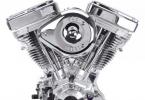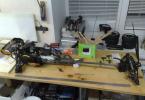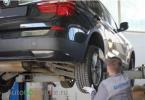Periodically, any brake system can malfunction. No car is protected from the fault, and especially if it is not always properly exploited. Very frequent procedure for maintenance with which you will have to face, it is pumping. With the help of the latter, you can get rid of air bubbles in the brake fluid that interfere normally slow down, or even can lead to system failure. Fortunately, it is easy to perform at home with their own hands. Also with brakes, the following problems can happen:
- When braking, the car begins to pull to the side.
- During braking pedal begins simply trembling.
- Behind the braking is heard a knock.
These manifestations say that everything is not so good with your brakes. As for the first two cases, it is most likely to help only replacing the brake pads or cylinders - they will definitely tell you in the service. The third manifestation says that you just need to tighten the caliper fastening bolts.
"Sorcerer", or, according to the catalog, the pressure regulator in the drive of the brake mechanisms, not in vain received in the people of such a tagged nickname: how it works, no one really knows, but they say, being faulty, it is able to present an unpleasant surprise - to make the car to put the car in case of emergency braking. In this, the cunning of the "sorcerer": when ordinary operating, without braking in the floor, his work or inaction is practically not felt, but when it is especially necessary to help, it can not be waited. Wassed pistons, breaking the thrust or lever of the drive, or instead of a faulty regulator you installed a new one, but for the time being you do not know that the node is defective or deregulated ... How dangerous is it?
Check in our experiment, as "witchcraft" affects the effectiveness of the brakes with partial and with the full load of the Chevrolet-Niva and Kalina and what should be feared by the owner who does not follow the state of the regulator. A malfunction, from excessive activity to complete inactivity, simulate adjustments. Recall that the challenge of the regulator is to reduce the braking force on the rear axle, reducing the likelihood of driving when braking to the SOZ. The regulator, fixed on the body and bound by the elastic lever with the beam of the bridge, limits the pressure in the rear brake mechanisms depending on the position of the back of the body relative to the road, that is, from the loading of the car.
"Chevrolet-Niva"
By the way, before testing tires on cars without ABS, each time we adjust a slightly adjustment regulator, taking into account the state of the road (snow, ice, asphalt), seeking blocking the rear wheels a little later. Let's not violate the tradition. Our "Shniva" turned out to be a gap between the cheaps of the regulator in 16 mm, which was put up with a stubborn screw.
Several braking, and a braking path from 80 km / h for a partial load machine defined: 34.4 m. With the fullest load ... 33.6! Almost the meter in short! At the same time, the driver noted a sick pedal and quick heating of the brakes that demanded cooling before each measurement. We will remember these parameters and make adjustments to the "sorcerer". To begin with, reducing the gap to 8 mm. Now the regulator significantly limits the pressure in the rear brake mechanisms, transferring almost the gravity of work to the front.
It became more difficult to slow down, keep the front wheels from the breakdown to the UZ is not so simple - they are blocked very sharply and the car, naturally, loses control. However, the result, to our surprise, the same as in the basic version: 34.4 m.
With full load, it is necessary to put pressure on the pedal much more, the front brakes begin to overheat. The result is 37.8 m. This is 4.2 m greater than in the basic adjustment (33.6 m).
The third state is to reduce the influence of the regulator, increasing the gap from the source is also 8 mm, that is, exhibit 24 mm. When in the car two, the braking path is practically not changed - 34.3 m. However, rear wheels are now blocked. But with the full load, the braking is very effective, slowdown is easy to manage and the result is recorded: only 30.8 m!
With a regular position of the regulator with an increase in the mass of the car, its braking path is reduced - the more complete use of the hooking with rear wheels is affected. Better braking - with full load when the regulator minimally limits the pressure in the rear brake mechanisms. However, with partial load, it is fraught with a drift. The high center of gravity and the short base of "Shniiva" contribute to a significant redistribution of masses when braking, therefore, with partial load, the rear axis contribution to the braking is small.
"LADA KALINA"
I exhibit the regulator so that the tail is slightly late with the locking of the wheels. With this setting and partial load, the machine was needed to stop only 27 m. Fully loaded - 29.5 m. There are small difficulties with a warning of a breakdown in the SOZ front wheels. We reduce the gap in the regulator to zero - the semi-empty "Kalina" stops after 31.8 m. Increase the brake path by 4.8 m, accompanied by a sharp lock of the front wheels. The loaded slows down after 35.2 m, the deterioration is even more - 5.7 m! Effort on pedals Increased, brakes are significantly heated.
Now the regulator shifts so that the rear brakes work as efficiently as possible. With partial load, the rear wheels are dramatically blocked and the car takes from the course - you have to let go of the pedal. On the verge of blocking to slow down is very difficult. The result is 30 m, which is 3 meters worse than "norms". The full load gave the result of 26.9 m, which is 2.6 m better basic (29.5 m). Notes regarding slow motion management.
With the basic position of the regulator with an increase in the load, the brake path increases. With partial load, the scatter of results is 4.8 m, therefore the basic position is most effectively. With deviation from it in any side, the brake path increases.
On a fully loaded car, depending on the position of the regulator, the variation of the length of the brake path is 8.3 m. The best results, as well as on "Niva", with an increase in pressure in the rear brakes. However, on a slippery road, even in smooth turns, an early blocking of the rear wheels, leading to the drift, is possible. And with a partial load at the position of the regulator, different from the base, the brake path only increases.
"Sorcerer" or ABS?
Nevertheless, such a regulator on a modern car - a dedication of antiquity deep. With ABS, it cannot compete with ABS, especially if an average driver who does not own extreme driving techniques are driving. Curb masses "Kalina" and "Priors" are almost the same - the difference is less than a percent. On the same tires that stood on Kalina, Priora with ABS showed the best results for any download. And no dosing effort on the brake pedal was not required, just click from the soul, and the rest does the electronics.
The optimal adjustment of the "sorcerer" corresponds to the averaged factory settings, and several percent can only be winning with individual correction for specific brake pads, tires, car load and road conditions. Only someone will hardly begin every trip from a trial run.
It would seem that one can reduce the braking path by increasing the pressure in the rear brakes, but it threatens the stability loss due to early blocking the rear wheels. And the maximum braking efficiency today can only provide ABS.
Checking and adjusting the brake system Chevrolet Niva
Verifying the tightness of hydropryryvoda
Check the tightness outdoor inspection:
top from under the hood;
from the bottom of the car (on the lift or observation ditch);
from sides with removed wheels.
Inspection of a part of a hydraulic pressure running under pressure, spend with an assistant. It must press 4-5 times on the brake pedal (creating the pressure in the hydraulic industry) and keep it pressed until you inspect the hydraulic engine. An inspection of a hydraulic pressure under pressure, let's say, but less effective.
If the connections are detected, tighten the clamps, plugs, nuts.
Hoses and pipelines that have mechanical damage replace.
If the wheel cylinders are detected, repaired or replace the cylinders.
You will need: "15" key, a special key for fastening pipelines or "10" key.
This is how the special key for the fastening of pipelines looks like.
1. Inspect the main cylinder tank,

2. Compounds of pipelines with the main cylinder.

3. Check if there is no fluid leakage in brake tubes connections with tees,

4. With pressure regulator. If the leaks are detected, pull the brake tubes (use a special key).

5. Carefully inspect brake hoses. They should not have cracks, supervisors and traces of wiping. Press until you stop on the brake pedal. If the hose appeared in bloating, then the threads of the hose braid were broken and it must be replaced.

6. Check the fastening of pipelines in the holders. The weakening or breakage of the holders lead to vibration and, as a result, to break the pipelines.

7. Check the condition of the pipelines on the rear axle crankcase.

8. Inspect the hose connection with a wheeled cylinder, a fitting for the air of the brake mechanisms of the front and

9. Rear wheels.

Vacuum Amplifier Performance Check
At the failure of the vacuum amplifier, the effort on the brake pedal is significantly increasing, which negatively affects the driving car. If the effort on braking pedals during braking increased markedly compared to the usual, check the brake amplifier on a fixed car.
You will need: screwdriver, rubber pear.
1. When the engine is not working, click on the brake pedal 5-6 times. Holding the brake pedal in the pressed position, let the engine. The brake pedal must move forward. If this did not happen, check

2. Landing density of vacuum hose on the fitting of the inlet pipe and

3. On the check valve. If necessary, depending on the defect, tighten the hose fastening clamp, replace the clamp or hose.

Weakening fasteners, damage to parts are not allowed. Weakened mounts tighten, damaged parts replace.
4. To check the check valve, disconnect the vacuum hose from the valve.
5. Remove the valve from the amplifier housing.
6. Put on a larger diameter fitting (with which the valve is inserted into the amplifier) \u200b\u200brubber pear and squeeze it. Wherein

7. Air must go through the valve. Release the pear. If it remains in a compressed state, then the valve is correct. Otherwise, replace the valve. In the absence of pear, you can blow the mouth valve.

Checking the degree of wear of the brake pads
If during braking the car takes to the side or a surveillance noise is heard, check the condition of the brake pads.
1. Install the car on the lift.
2. Remove the front wheel.
3. Check through the hole in the brake brake body the state of the pad. If the thickness of the friction linings is about 1.5 mm, replace the pads.

4. To check the degree of wear of the brake pads of the rear brake mechanism, remove the rubber plug from the hole in the brake shield and

5. Inspect the pads of the pads.

Replace pads in the following cases:
the thickness of the lining is less than 1.5 mm;
the surface of the lining of the gromacena;
the lining is fragile with the base.

Check and adjust the pressure regulator
If the pressure regulator malfunction is malfunction during intensive braking, the rear wheels are possible before the front, which will lead to the car drift.
Check the pressure regulator with the helper from the bottom of the car installed on the lift or viewing ditch.
You will need: screwdriver, keys "on 10" (two).
1. Ensure that the pressure regulator and part of its drive are damaged, there is no damage to the leakage of the brake fluid.
2. Ask the assistant to click on the brake pedal.
3. When you press the pedal with an effort 70-80 kgf, the piston should be moved out of the housing, twisting the torsion lever.
To clearly define the movement of the piston, insert a screwdriver between the adjusting screw and the piston lever. When moving the piston, the screwdriver will also move.
4. If, when you press the brake pedal, the piston remains fixed, then the pressure regulator and it should be replaced with the new one.
Adjusting the rear brake pressure regulator drive is necessary when weakening the bolts of its attachment, as well as after any work related to the removal of the rear axle beam, replacing the springs and rear suspension shock absorbers.
5. To adjust, post the rear axle of the car.
6. Loosen the locknut 1 of the adjustment bolt 2.
.jpg)
7. Watching the adjusting bolt key 1, achieve a light contact of the bolt with a 2 piston lever.
.jpg)
8. Wrap the adjusting bolt another turnover and tighten the lock nut.
9. With proper adjustment of the rear brake pressure regulator drive, the rear wheels should be blocked with a sharp braking somewhat later than the front.
Check when braking from a speed of 30-40 km / h.
Check and adjust the free stroke of brake pedal
If the free stroke of the pedal is greater than the norm, the efficiency of the brakes is reduced due to the decrease in the full pedal stroke. With an excessively small or missing free course, spontaneous braking and brake heating is possible.
The free stroke of the brake pedal with a non-working engine should be 3-5 mm.
You will need: emphasis, line, key "at 19".
1. Install the ruler next to the pedal to the end to the floor, orienting it in the middle of the pedal site. Mark on the line or remember the position of the pedal.

2. Press the stop (you can use the hammer handle) to the pedal, moving it to the appearance of a tangible increase in the effort of moving. Determine the movement of pedals in the line, which will be free pedal.

3. If the free move of the brake pedal goes beyond the permissible limits, adjust it by weakening the tightening nut of the braking signal switch and

4. Watching or turning the switch in the bracket (with a large free trip, screw the switch to the bracket towards the pedal, with a small free progress or there is no absence of its lack of switch from the bracket, giving it from the pedal).

5. Check the free stroke of the brake pedal again. Tighten the braking signal fastening nut.
6. Connect the wires to the switch (if they are disconnected) and check the operation of the stop signals.
Check and adjust the parking brake
The parking brake must hold the car on a slope of 25% when moving the lever in the car cabin at 7-9 teeth (clicks) of the ratchet device.
1. To verify the correctness of the adjustment of the parking brakes, go near the parking lot of your car overpass, loading ramp, etc. High height H \u003d 1.25 M with the length of the entrance L \u003d 5 m. This ratio corresponds to the slope of 25%.

2. In the absence of such a ramp for simplified parking brake check, install the car on a flat site. Put the gear lever in a neutral position, lift the parking brake lever in the cabin. Get out of the car and try to move it off. If you managed it, it is necessary to urgently adjust the parking brake drive.
Adjust the parking brake drive from the bottom of the car installed on the lift or observation ditch.
You will need: two keys "at 12", tick type "Cobra" or Pasal.
1. Holding the key 1 adjusting nut, 2 loosen the lock nut.

2. Holding the cable with ticks, wrapping or screwing the adjusting nut, achieve the course of the lever for 7-9 clicks.

3. Tighten the lock nut.
4. Perform a few full moves of the lever, then lower the lever until you stop.
5. Turn the back wheel with your hand. They must rotate evenly, without jerks. Otherwise, repaired the drive of the parking brake or the brake mechanisms of the rear wheels.
Checking the efficiency of the brake system
Check the efficiency of the brake system is preferably in special brake stands (similar to the traffic police used during the annual technical inspection of cars). In extreme cases, an indicative comprehensive assessment of the operation of the brake system can be carried out on a flat horizontal platform, closed to traffic. It is desirable that the site is covered with a thin layer of sand.
The car without load (with the exception of the driver) is offended on the first gear to the speed of about 15 km / h. Discoverly click on the brake pedal so that the wheels are blocked, and do not let go of the pedal until the car stops.
Exit the car and inspect the brake trails left by the wheels of the car. If the brake traces of the front wheels are somewhat longer than the rear, while the length of the tracks on the left and right is the same, the Totor-like system is good. Otherwise, repaired the system.

The following relations must be observed:
L lion. per. \u003d L right. per.
L lion. Rear. \u003d L right. rear.
L per.\u003e L rear.
Do not abuse such an assessment, for it is associated with increased one-sided wear of tires.
The brake system is one of the main components of the car, which allows you to react to interference in time in the stream of cars without causing emergencies. A slow reaction to pressing the pedal can cause a collision with ahead of the autmobil, and too sharp will create interference for cars from behind. And in general, any malfunction in the brake system invariably leads to the fact that the response time of the pedal decreases, the driver cannot predict the movement of the car and sharply grow a chance to get into an accident. One of the manifestations of a malfunction in the brake system can be that when braking beats the brake pedal Chevrolet Niva. If this problem occurs, it is necessary to immediately diagnose the brake system and eliminate the malfunction.
In the brake system of the car, there are not very many components that can fail and lead to this problem. If you started beat the brake pedal, then first of all it is necessary to check the main components of the system:
It is important to remember that the replacement of brake discs, pads or drums are made pairwise on each axis. After replacement, it is necessary to ride the parts slightly. This can be done several times slowing down when moving on the first gear. It follows the run in place where there are no people and other cars nearby, so that in the event of any problems, do not cause accidents.
What to do if the brake system is working.
If, with visual inspection, no faults have been detected, or after replacing any elements, the problem is still saved, it is necessary to check the following items:
- wheel balancing.
- pendant levers, fasteners
- brake System Fastening Elements
You should not ignore problems with the brake system. In the future, this can lead to more expensive repair or emergency situations on the roads.
Read 2 min.
Today's article is devoted to the car Chevrolet Niva and its brakes. Consider the nuances of operation and repair.
Chevrolet Niva is a product of the combined development of two companies, and the car came out, which is sufficiently comfortable and is fully ready for riding our roads. This amazing synthesis was very widely prevalent with us and is quite satisfactory for most of our consumers. Today we are interested in the brake system of this car, which is designed for driving conditions for off-road and the shortest possible way when driving in conditions of riding in urban conditions. We understand which systems are installed here and what the mechanisms are different from others.
General device
Chevrolet Niva combined two subsystems. Each brake system has its own purpose, they are called:
- Working.
- Parking.
The appointment of the latter is extremely clear, this braking system ensures the hold of the jeep of Chevrolet Niva in the same position with its parking lot on the uneven surface for a long time. The brake system, referred to as working, is regularly applied when the car is moving. With it, the driver slows down on traffic lights and stops the car where he needs. You can control its work with the help of a foot pedal, which is located to the left of the gas pedal and to the right of the clutch, if it is, of course, is.
Principle of operation
In Chevrolet, the Niva was decided to use the standard hydraulic drive of the system operation and the combined mechanism. A disc braking mechanism was installed on the front axle, and on the rear drum, as in the classic version of this car. But, unlike the original version of the car, the drive was modified. This braking system received a vacuum amplifier of the effort attached to the pedal and a more perfect main cylinder.
The disc mechanism of the Chevrolet Car Niva has two main details: disk and caliper. The disc has a tight engagement with the wheel hub and rotates with it, that is, the disk is a moving element. The caliper is attached on a special bracket over the disk. Inside it the pads and working cylinders are inserted, which pressed the pads to the disk. The drum is a bit different design, here the rolling part performs the hull of the drum, which inside itself hides wider pads. Here, workers cylinders pressed wider pads to the horizontal plane of the drum. This design has a higher efficiency due to broader and long shoes. In addition, all the mechanisms are hidden inside the drum and are completely protected from external influence. It is very convenient if the machine is often used in off-road driving conditions.



